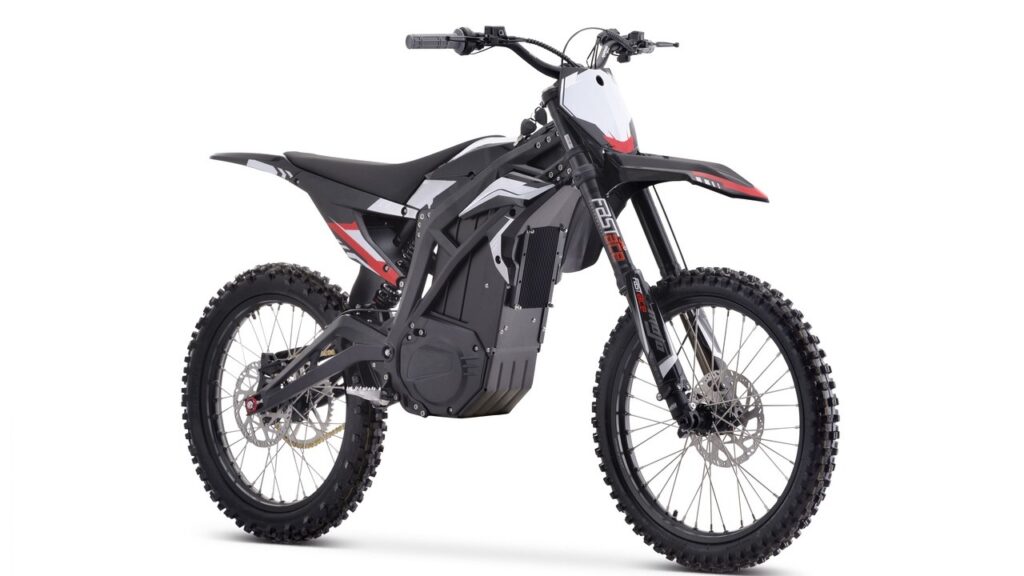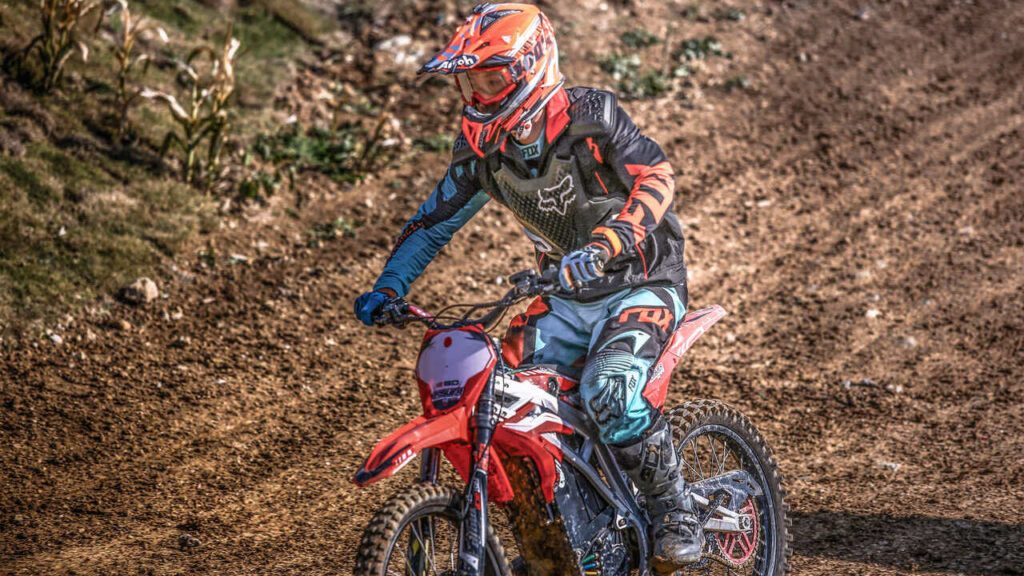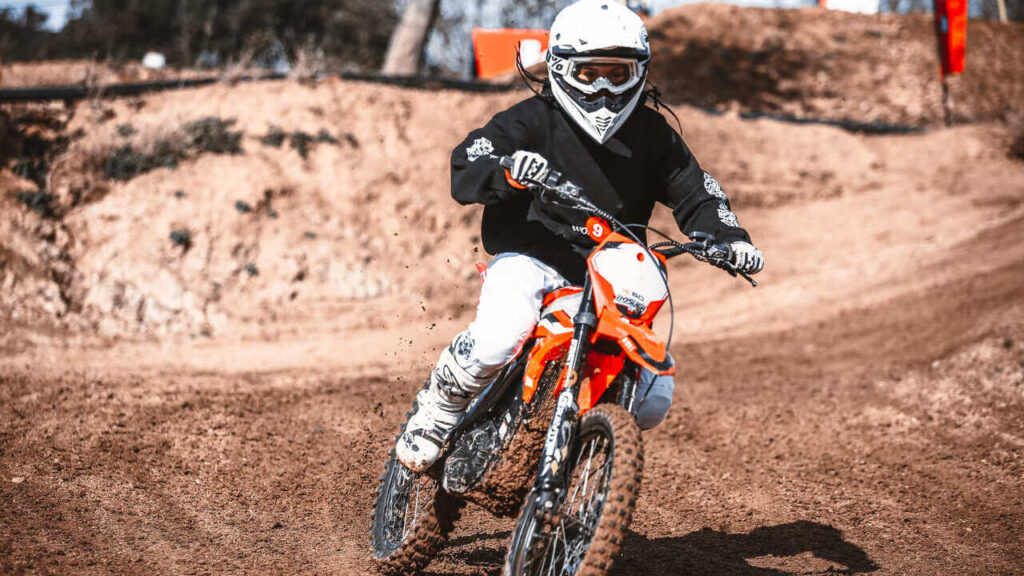If you are a dirt bike retailer, distributor, or professional rider, you’ve likely seen the rising popularity of electric dirt bikes and might wonder if they’re the future—or just a passing trend. Traditional gas-powered dirt bikes have long dominated the market, but electric models now offer compelling reasons for riders to make the switch.
In this post, we’ll clearly break down the differences between electric and gas-powered dirt bikes, providing actionable insights so you can confidently decide which models to stock. Let’s dive in!
Understanding Gas and Electric Dirt Bikes
Gas-Powered Dirt Bikes
Gas-powered dirt bikes have dominated the off-road motorcycle market for decades. They rely on internal combustion engines that need gasoline. These engines create power by burning fuel inside a cylinder which makes the bike move.
These types of dirt bikes also have a gas tank to store fuel and a system to burn those gases that produce smoke or other types of waste products. Riders are needed to refuel the bike when the gas tank is low.
Electric Dirt Bikes
Electric dirt bikes use a motor that runs on a battery instead of fuel. The battery powers the motor, which creates movement. They have no fuel tank, gears, or exhaust systems, so they require much less upkeep. A battery will always need to be charged, and the time spent riding is based on the battery’s capacity. These dirt bikes deliver power quickly so that they can offer instant torque without gears or clutch, making them user-friendly and beginner-friendly.

Performance Comparison: Gas vs. Electric Dirt Bikes
Let’s put electric and gas dirt bikes head-to-head and see how they perform in the field:
Speed and Acceleration
Gas-powered dirt bikes typically offer higher top speeds, often reaching 60–80 mph (95–130 km/h) or more, depending on engine size and model. However, they accelerate more gradually because riders must manually shift through gears to build speed.
In contrast, electric dirt bikes generally have lower maximum speeds, usually around 30–60 mph (50–95 km/h). But they deliver immediate acceleration thanks to instant torque from their electric motors, providing faster initial response and better performance in technical terrains or trail riding conditions.
If you’re curious how fast your dirt bike can go, remember it varies based on type, engine size, and purpose—gas dirt bikes excel in higher sustained speeds, while electric models are quicker off the line.
Power and Torque
Electric dirt bikes are powered with the twist of the throttle, and the power gradually increases with the RPMs. Electric dirt bikes take the lead when it comes to quick rides and off-roading. They’re not ideal for long rides or extensive solemn terrains.
Besides, electric dirt bikes offer peak torque from the very beginning which gives them an advantage in steep climbs and narrow trails. However, these bikes do have limitations; their battery life can hinder sustained power over longer distances.

Weight And Handling
One of the most obvious differences between dirt bikes is the dirt bike weight. Gas dirt bikes are more likely to be heavier than electric dirt bikes due to their tanks, engines, and exhaust systems. Riders are required to control the bike and balance while riding in uneven terrain regions.
In addition, electric dirt bikes are usually more lightweight compared to gas-powered ones because of fewer mechanical parts. Their lower center of gravity makes them easier to control which is usually great for beginners. While battery weight is a factor in the overall feel, the design does matter when it comes to electric dirt bikes.
Riding Experience & Convenience
Noise Levels
Dirt bikes that are gas-powered have an increased level of noise due to their combustion of dirt bike engines, which can be enjoyed by some riders but may serve as a distraction for others.
Electric dirt bikes produce a light humming sound from the motor. Compared to gas-powered dirt bikes, electric dirt bikes are nearly silent. Their quietness makes riding in noise-sensitive places convenient and allows for a more relaxing experience.
Vibration & Smoothness
Gas dirt bikes make noticeable vibrations with the help of the engine, especially at high speeds. With gas dirt bikes, riders can fatigue easily during long rides. In addition, riders need to adjust to the movement of the bike which makes riding gas dirt bikes tiring.
When riding electric dirt bikes, the smoothness is unmatched alongside the absence of engine vibrations. Riders will be pleased with the fact that the power delivery is steady throughout the ride which provides comfort and satisfaction during the ride instead of strain.

Cost Analysis: Initial Investment & Long-Term Expenses
Just like fuel-powered dirt bikes, electric dirt bikes also have an initial cost that is on the higher side. However, their operational expense is much lower than their fuel-powered counterparts. Moreover, dealers have the chance to brand electric models as an investment, attracting customers willing to achieve savings over time.
Gasoline-powered dirt bikes come with the additional benefit of attracting a large number of people because they can be bought at a much lower initial price. However, when accounting for fuel expenses, maintenance, and possible repairs, the expenses escalate very quickly. This enables dealerships to provide more comprehensive service contracts as well as sell premium, profit-rich add-ons.
At first glance, gas-powered dirt bikes seem cheaper, ranging between $3,000–$10,000 compared to electric models at $4,000–$12,000. However, considering these additional costs, over a 5-year period, the total cost of owning an electric dirt bike can often end up being lower, despite the higher upfront investment. Consider marketing electric bikes as cost-effective investments over time.
Environmental Impact & Sustainability
Gas Emissions Vs Clean Energy
Dirt bikes that use gas emit carbon dioxide when fuel is burned. Gas-powered engines emit harmful substances, which include carbon monoxide, nitrogen oxides, and many other constituents of air pollution that lead to global warming.
Electric dirt bikes, on the other hand, do not produce emissions during riding. Electric dirt bikes operate on clean energy and no emission is produced especially during charging if the electricity is from renewable sources.
Sustainability
While electric motorcycles lessen emissions, concern about emissions is now shifted to the batteries. Lithium and cobalt are needed in the manufacturing process of the batteries. Their extraction is harmful to ecosystems and there is the problem of waste management when the batteries die. However, new solutions are being developed that focus on battery recycling and eco-friendly compounds, significantly increasing the net positive impact on the environment over time.
On the other hand, gas dirt bikes are operated with fossil fuel which is non-renewable and polluted. Its consumption during operation makes fossil fuels unsustainable over time.
Government Incentives
Governments around the world provide financial aid and tax credits for electric dirt bikes to forward emission-free bikes. These tax and financial credits are beneficial in neutralizing the cost and promoting emission-free transportation. Some of these regions also implement rebates or grants for energy-efficient anti-pollution measures such as battery recycling.
Gas dirt bikes do not receive any tax benefits like other electric dirt bikes, and are more likely to be regulated in the future with emission control limitations.
In conclusion, electric dirt bikes may be expensive but put forward a resourceful alternative. Sustaining batteries still poses a challenge, not taking away the positives.
Range & Refueling/Charging Convenience
Gas Tank Capacity vs. Battery Life
Gas dirt bikes generally feature a fuel tank between 1 and 3 gallons. With a full tank, they can range anywhere from 50 to 150 miles based on the engine size and riding conditions.
Electric dirt bikes primarily depend on battery capacity, typically providing a range of 30 to 80 miles per charge. While more high-performance models equipped with larger batteries range farther per charge.
Refueling vs. Charging Time
Simply refueling a gas dirt bike takes only a few minutes, enabling gas riders to quickly resume their journeys.
Electric dirt bikes need to be charged, which ranges from 1 to 10 hours depending on the charger type and battery size. While fast chargers can significantly reduce the charging duration, they are not always accessible.
Availability of Charging Stations
Gas stations are available almost everywhere, which makes it easy to refuel.
Charging stations are growing in number, but are still not very common in remote areas. Many riders charge at home while some use spare batteries for longer trips.
While gas dirt bikes have a longer range and can be refueled quickly, electric dirt bikes are more time-consuming to plan trips around but provide a cleaner, quieter ride.
Gas vs. Electric Dirt Bikes: Pros and Cons Summary Table
| Feature | Gas-Powered Dirt Bike | Electric Dirt Bike |
| Speed & Acceleration | Higher top speed, gradual acceleration | Lower top speed, instant acceleration |
| Power & Torque | Strong power but builds with RPMs | Instant torque, great for climbs |
| Weight & Handling | Heavier due to engine and fuel tank | Lighter, easier to handle |
| Noise Levels | Loud engine sound | Quiet, near-silent operation |
| Vibration & Comfort | More vibration from the engine | Smooth, no engine vibrations |
| Ease of Use | Requires shifting gears and clutch control | No gears, twist-and-go operation |
| Upfront Cost | Lower initial cost ($3,000–$10,000) | Higher initial cost ($4,000–$12,000) |
| Maintenance & Repairs | High maintenance (oil, filters, engine parts) | Low maintenance (no oil, fewer moving parts) |
| Fuel vs. Charging Cost | Ongoing fuel expenses | Lower electricity costs |
Suitability for Different Riders & Use Cases
For Beginners Vs. Experienced Riders
Electric dirt bikes are easier for novices, as there are no gears and no clutch. They have low acceleration and simple maintenance, making them forgiving for novices.
Gas dirt bikes do require practice, as the riders have to learn how to shift, manage throttle, and so on. They are very popular among advanced riders because of the power and petrol range it offers.
For Racing Vs. Leisure Riding
Gas dirt bikes are sup-range fueled powerhouses with high top speeds. Professional riders prefer them for long tracks because of the endurance and performance it offers.
Electric dirt bikes can be used as power-enhancing accessories or as electric bicycles for leisure activities. They are ideal for trail rides and beat rides because they have effortless power delivery.
For Motocross
Gas dirt bikes are better for off-road riding. Their long range and high durability allow them to handle rough terrain, steep climbs, and long-distance trails. Electric motocross bikes outperform traditional gas dirt bikes in regard to urban commuting. Their low-noise motor and lack of emissions make them ideal for eco-friendly travel.
As expected, both types serve different needs, with gas dirt bikes excelling in endurance and rugged use while electric dirt bikes are more reliable and easy to use.
Gas dirt bikes offer power, range, and quick refueling, while electric dirt bikes provide smooth, eco-friendly, and low-maintenance riding.

Electric or Gas Dirt Bikes: Which Suits Your Customers?
Retailers should carefully match dirt bike types with specific rider preferences and usage scenarios. Here’s a simple breakdown to help guide your inventory decisions clearly:
For Beginners and Casual Riders
Choose electric dirt bikes. Their simple twist-and-go operation—no gears or clutch to manage—makes them easy and safe for beginners. They also require minimal upkeep, providing a worry-free riding experience.
For Competitive and Advanced Riders
Opt for gas dirt bikes. With higher top speeds, longer riding ranges, and quick refueling, gas-powered models remain optimal for motocross competitions and professional off-road racing.
For City and Eco-Conscious Riders
Recommend electric dirt bikes. Quiet operation, no direct emissions, and minimal maintenance make electric models ideal for urban and suburban riding environments, appealing to eco-conscious customers.
Future Trends: Are Electric Dirt Bikes the Future?
Electric dirt bikes are rapidly gaining market share due to their environmental benefits, ease of use, and lower long-term costs. Major manufacturers are expanding electric lines in response to consumer demand.
Future of Electric Dirt Bikes
Due to the growing number of young riders and urban consumers, the demand for electric dirt bikes is increasing. Existing manufacturers are increasing their new electric offerings which is a good indicator of growth. By stocking electric models, your dealership can take on the position of an innovative company that is responsive to changing market needs.
Future of Gas Dirt Bikes
A majority of seasoned riders prefer traditional gas dirt bikes for their expediency and power. While electric dirt bikes are growing in popularity, gas-powered models continue to have a solid customer base. Because of this, dealerships are ensuring a steady stream of sales for off-road racing enthusiasts.
Advice for Retailers
Consider a balanced inventory to cater to diverse customer segments. Position your dealership as forward-thinking by highlighting electric models, while maintaining a robust offering of proven gas models for traditional enthusiasts.
Final Verdict: Which Dirt Bike Type Should You Stock?
There’s no one-size-fits-all answer—your inventory should reflect the diverse needs of your customers:
- Wholesale Electric Dirt Bikes: Ideal for beginners, urban riders, environmentally-conscious buyers, and casual trail enthusiasts.
- Wholesale Gas Dirt Bikes: Perfect for competitive riders, motocross enthusiasts, and those requiring extended range and consistent high-speed performance.
By clearly understanding your customers’ riding styles, budgets, and preferences, you can strategically stock dirt bikes to maximize sales and customer satisfaction.
At BSE Motor, we’re committed to quality and performance. Whether you are looking for gas-powered or electric dirt bikes, enduro motorcycles, or motocross motorcycles, we have all the vehicles you need to boost your business. Visit our dirt bike supplier site to explore premium dirt bikes, parts, and accessories.
Contact us today and let our team help you choose the perfect inventory lineup tailored to your customers’ needs.
